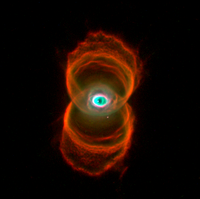The Engraved Hourglass Nebula (also known as MyCn 18) is a young planetary nebula situated in the southern constellation Musca about 8,000 light-years away from Earth. It was discovered by Annie Jump Cannon and Margaret W. Mayall during their work on an extended Henry Draper Catalogue (the catalogue was built between 1918 and 1924). At the time, it was designated simply as a small faint planetary nebula. Much improved telescopes and imaging techniques allowed the hourglass shape of the nebula to be discovered by Raghvendra Sahai and John Trauger of the Jet Propulsion Laboratory on January 18, 1996. It is conjectured that MyCn 18's hourglass shape is produced by the expansion of a fast stellar wind within a slowly expanding cloudwhich is denser near its equator than its poles.
The Hourglass Nebula was photographed by the Wide Field and Planetary Camera 2 of the Hubble Space Telescope.
A less-famous "Hourglass Nebula" is located inside the Lagoon Nebula.
Hourglass Nebula in popular culture
- The Hourglass Nebula was featured on the cover of the April 1997 issue of National Geographic. The nebula’s unique appearance led the magazine’s editors to comment, “Astronomers looked 8,000 light-years into the cosmos with the Hubble Space Telescope, and it seemed that the eye of God was staring back.”
- The Hourglass Nebula appears in the popular game, Final Doom.
- The Hourglass Nebula appears on a poster in the CERN laboratory in the film Angels & Demons.
- The Hourglass Nebula appears extensively, and is used as a major plot point in the 2002 animated series Space Pirate Captain Herlock: The Endless Odyssey.
- The Hourglass Nebula appears in the video game titled Mass Effect 2 as one of the clusters that can be visited for missions.
- The Hourglass Effect is a 2008 album by the British band Shadowkeep.

No comments:
Post a Comment